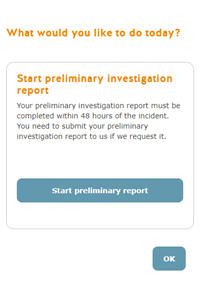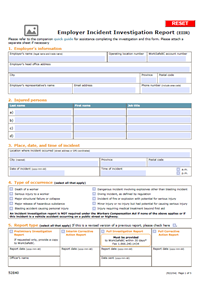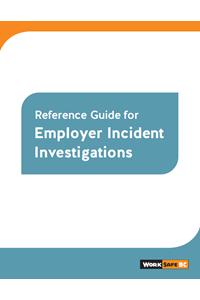Conducting an employer investigation
Employers are responsible for investigating certain incidents or near-misses that take place in the workplace and submitting an investigation report to WorkSafeBC. These investigations help employers and WorkSafeBC determine why an incident happened and what can be done to prevent similar situations in the future.
- Incidents requiring an investigation
- Investigation stages
- Reports and the reporting process
- Ways to submit an Employer Incident Investigation Report (EIIR)
- Resources
Incidents requiring an investigation
Employers are responsible for immediately conducting an investigation into any incident that involves:
- Serious injury to a worker or a worker's death
- Injury requiring medical treatment
- Minor injury, or no injury, but had the potential for causing serious injury
- Major structural failure or collapse
- Major release of hazardous substances
- Diving incident, as defined by the Occupational Health and Safety (OHS) Regulation
- Dangerous incident involving explosive materials
- Blasting incident causing personal injury
Section 69 of the Workers Compensation Act provides more details about what incidents employers must investigate.
Investigation stages
Conducting an investigation into an incident that occurred in your workplace includes four stages. Those conducting the investigation must be knowledgeable about the type of work involved at the time of the incident. An employer and a worker representative must participate, if or as they are available.
The four stages of an investigation are:
-
1
Preliminary investigation
A preliminary investigation is an opportunity for employers to identify any unsafe conditions, acts, or procedures that must be addressed so work can resume safely until a full investigation has been completed. Employers must complete a preliminary investigation and accompanying report within 48 hours of an incident.
-
2
Interim corrective actions
During the period between the incident and the conclusion of the full investigation, an employer is responsible for taking all actions reasonably necessary to prevent the incident from happening again. If you can identify only some of the unsafe conditions, acts, or procedures that significantly contributed to the incident, interim corrective actions may include a full or partial shutdown of the worksite, removal of equipment, or reassignment of workers to other duties.
-
3
Full investigation
A full investigation is about determining an incident's cause or causes. This involves carefully analyzing the facts and circumstances to identify the underlying factors that led to the incident. Key questions to ask include:
- What factors made the unsafe conditions, act, or procedures possible?
- Are there any health and safety deficiencies in my management system or processes?
A full investigation and report must be completed within 30 days of the incident.
-
4
Final corrective actions
Once a full investigation has been completed, as an employer you must prepare a corrective action report that describes the unsafe conditions that led to the incident, what corrective action is necessary, and the steps you and your organization will take to implement those actions.
Reports and the reporting process
Depending on the incident, employers are responsible for completing up to four separate reports — each representing the investigation's status at a specific point in the process. Employers can choose to document the incident investigation in a format that suits their needs; however, the reports must contain the information required by WorkSafeBC Prevention Policy Items P2-71-1 and P2-72-1. This will ensure reports comply with sections 71(2)(a) and 72(2)(a) of the Workers Compensation Act.
To support employers in meeting this responsibility, WorkSafeBC offers both an online reporting tool and PDF template (Form 52E40). Employers can use either method to record their incident investigations. It's important to note that the reporting tool and template contain the minimum content required to satisfy the Act. If you choose to customize any of the report forms, you may add fields but be sure not to delete any. For more on completing a report, see the Reference Guide for Employer Incident Investigations.
As you complete these reports during your investigation be mindful of the personal privacy of individuals involved in the incident. Only record personal information that is relevant to the investigation. If personal information is included, consider removing some or all of it before posting the report in a public place.
The following describes each of the required reports in more detail.
1. Preliminary investigation report
The preliminary investigation and its accompanying report must be completed within 48 hours of the incident — unless WorkSafeBC grants an extension. This report outlines the facts of the incident, including the names of injured workers and witnesses. It also asks you to describe the sequence of events leading up to the incident and what happened when the incident occurred. In addition, you are required to identify the unsafe conditions or acts that significantly contributed to the incident and list the recommended corrective actions.
Once you've completed the preliminary investigation report, make sure you keep a copy for your records. You may need to submit a copy to WorkSafeBC, if requested. You must also provide a copy to your joint health and safety committee or the worker health and safety representative. If there isn't a joint committee or worker representative at your organization, you must post a copy at your workplace for everyone to read (being mindful of any privacy concerns).
2. Interim corrective actions report
The interim corrective actions report should address the findings of your preliminary investigation and describe the recommended steps taken to prevent similar incidents.
Once you've completed the interim corrective actions report, make sure to keep a copy for your records. You must also provide a copy to your joint health and safety committee or the worker health and safety representative. If there isn't a joint committee or worker representative at your organization, you must post a copy at your workplace for everyone to read (being mindful of any privacy concerns).
3. Full investigation report
The full investigation and accompanying report must be completed and submitted to WorkSafeBC within 30 days of the incident. The full investigation report expands on the preliminary investigation report by describing what your investigation has determined to be the cause or causes of the incident. You may need to update the section on the unsafe conditions, acts, or procedures that led to the incident (in other words, the underlying factors), as well as your recommended corrective actions.
Once you've completed the full investigation report, make sure to keep a copy for your records. You will need to submit a copy to WorkSafeBC within 30 days. You must also provide a copy to your joint health and safety committee or the worker health and safety representative. If there isn't a joint committee or worker representative at your organization, you must post a copy at your workplace for everyone to read (being mindful of any privacy concerns).
4. Full corrective actions report
Once the full investigation and report have been completed, you are responsible for preparing a corrective action report identifying:
- The unsafe conditions, acts, or procedures that made the corrective action necessary
- The corrective action(s) taken to prevent similar incidents from occurring in the future
- The names and job titles of those responsible for implementing the corrective action(s)
- The date of completion for the corrective action(s)
After the full corrective actions have been put into place, it's recommended you take some time to review them to determine if they have been effective.
Once you've completed the full corrective actions report, make sure to keep a copy for your records. You must provide a copy to your joint health and safety committee or the worker health and safety representative. If there isn't a joint committee or worker representative at your organization, you must post a copy at your workplace for everyone to read (being mindful of any privacy concerns).
Ways to submit an Employer Incident Investigation Report (EIIR)
Generally, you are only required to submit a full employer incident investigation report (EIIR) form to WorkSafeBC. You can submit full investigation reports in the following ways:
- Through our online reporting tool, which includes convenient features such as being able to:
- Create preliminary and full investigation reports
- Prepopulate information from your preliminary report
- Save a partially completed report
- View any prior reports submitted through online services
- If you are using our fillable PDF template or your own reporting template, you can upload your report to us.
- Alternatively, you can fax your report to 604.276.3247 (toll-free at 1.866.240.1434) or send by mail to: WorkSafeBC, PO Box 5350 Stn Terminal, Vancouver, BC V6B 5L5.
Highlights
- Human Factors Approach to Safety and Incident Investigations 2023 Published on: August 02, 2023
- Incident investigation reports can now be completed online Published on: April 28, 2022




